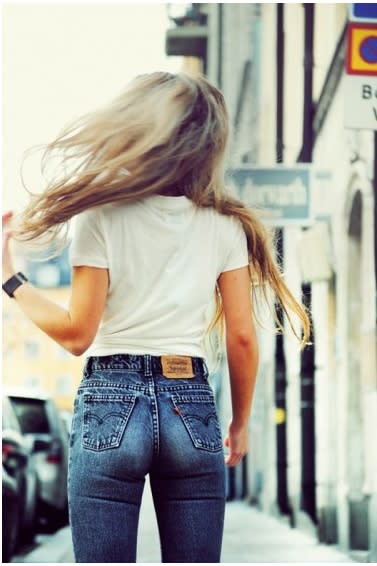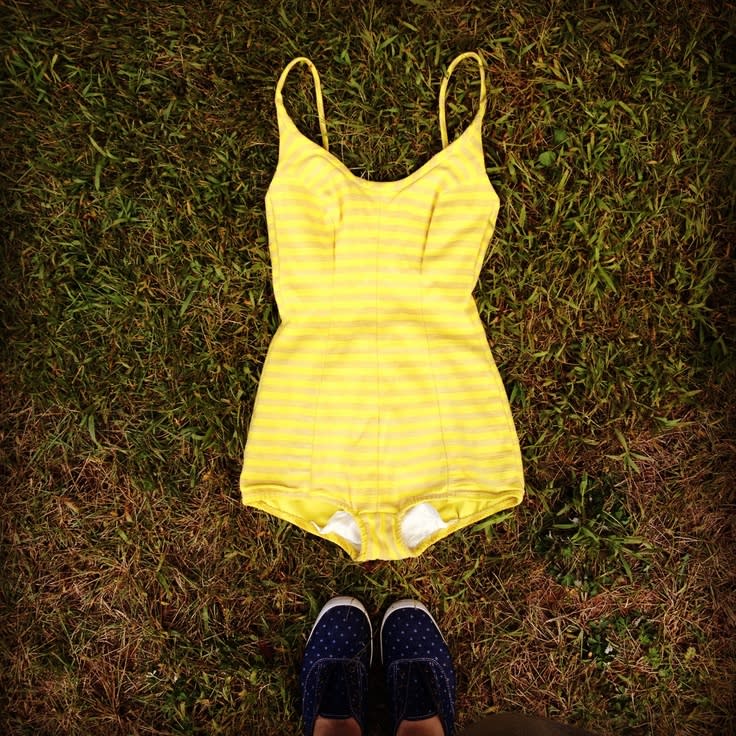How To Care For Every Item In Your Closet: 101 Tips

When it comes to general housekeeping, it sometimes seems that everyone and their mother (literally!) have tried-and-true tips and tricks they absolutely swear by, especially when it comes to caring for your clothing. Some are useful, while others … well, not so much. With that in mind, we’ve culled 101 tips on how to effectively care for every item in your closet, from cotton to denim. Read on for more!
More from StyleCaster
These 3 Men's Denim Trends Will Transform Your Summer Wardrobe
The Best Jeans for Tall & Long-Legged Ladies That Money Can Buy (Including Some Styles on Sale)
Click here to read the full article.
SILK
101. While dry-cleaning is fine for basic silk pieces, it’s even better to hand wash them in order to keep them in good shape.
100. Handwash silk in cool or lukewarm water using a tiny bit of mild detergent such as Woolite, Ivory soap, or shampoo dissolved in water.
99. Like most natural fibers, silk doesn’t tolerate changes in temperature, so stick with either cool or warm water the whole way through.
98. Never wring out silk to dry! Instead roll the item up in a towel and gently press the water out.
97. Wash items labeled “washable silk” (underwear, tank tops, etc) in the washing machine on the gentle cycle in a mesh bag. Hang dry on a padded hanger.
96. To prevent color loss and to keep silk in good condition, add up to three tablespoons of white vinegar for every two quarts of water.
95. Silk should be pressed while it’s still damp. Iron on a low setting and don’t use steam, which can leave watermarks.
94. Always store silk in a dry dark place, and never keep in it in plastic since the fabric needs to breathe.
JEANS
93. Serious denim aficionados know that raw denim (super-stiff jeans with no washes, fading, etc) can take up to six months to break in and thusly, shouldn’t be washed until then.Why? Jeans really do conform to our bodies, and when you wash them, most of the shape is lost.
92. Most jeans today, however, are treated (pre-washed to achieve a faded look) and don’t need to be broken in. These you can wash more often, but only when they’re stained or when they start to sag.
91. To zap odors: hang jeans in the bathroom before a shower (the damp steam will keep them fresh between washes), or freeze them in a plastic bag for two days.
90. Always wash jeans inside out in cold water on the delicate cycle, or by hand with Woolite. (If you actually want denim to fade quickly, wash once in hot water.)
89. Add a 1/2 cup of distilled white vinegar to the final rinse cycle while doing laundry to maintain the wash of your favorite pair of dark jeans.
88. Try not to machine dry denim pieces. If you have to, turn down the temperature to the lowest possible heat setting, and remove before they’re completely dry. Lay flat or hang upside down to dry.
87. Fold jeans like a pro: Lay jeans on a flat surface, fold in half from left to right. Grab the stacked jean legs and fold them in half so the hem of the jeans lines up with the waistband. Fold the jeans in half one more time.
86. Denim needs to breathe, so be sure to not pack folded pairs too tightly together on a shelf, or hand denim jackets or vests in a crowded closet
CASHMERE
85. Despite what it says on the tag, cashmere is best washed by hand in cold water with baby shampoo or Woolite for optimal softness and protection from chemicals (and only about two times a season).
84. Never hold up a wet cashmere sweater by the shoulders, it’ll stretch it out. In fact, keep your cashmere in a lump when you go to pick it up when wet.
83. To dry it quickly, use a salad spinner, which releases excess water in seconds. Don’t have one? Lay it flat to dry, pressing it gently with a towel.
82. Always fold cashmere sweaters in thirds so you don’t get a fold line running down the front of the sweater.
81. Always clean cashmere before storing it for the winter, as moths are attracted to our everyday scents, such as perfume, food, deodorant, and smoke.
80. If you do dry-clean your cashmere, be sure to remove all garments from the protective plastic immediately. Wrap them in tissue paper and place in cedar-scented bags instead.
COTTON
79. Cotton is super-durable, so garments can be washed in the machine with any detergent, and bleach can be used as needed.
78. For best results, machine wash cotton items in warm water on a normal wash cycle.
77. Tumble dry on low setting.
76. If your cotton is white, you can wash it with bleach on a hot water setting.
75. When to keep cotton towels, robes, and washcloths fluffy, use half the amount of detergent and run them through an extra rinse cycle (detergent residue can diminish softness).
74. Cotton wrinkles easily but can be ironed on the highest heat level.
VISCOSE/RAYON
73. Viscose has a silky appearance and feel, it breathes like cotton, can be easily draped, and it’s lightweight. However, it wrinkles very easily, so it’s advised to use an iron’s medium setting with steam.
72. If the garment is particularly special or has intricate draping, hand-washing is suggested in cool to lukewarm water.
71. Hang wet items totally wet (no wringing or twisting) as this will help remove creasing and ensure the garment doesn’t lose its shape.
LEATHER JACKET
69. Before wearing a leather jacket, treat it first with scotch guard or a similar spray to help prevent the ingress of water, stains or grime.
68. The best way to keep leather clean is to simply use a damp cloth
67. When you take your jacket off, hang it on a well shaped hanger as often as possible. Like leather shoes, the material stretches out easily.
66. Leather jackets are more prone to water stains when they’re not properly treated, and while you should avoid taking them out in rainy weather, it’s also important to hang your jacket in a dry, well-ventilated closet.
65. Put a leather conditioner on areas that get overly dry. Also, salt can stain leather, so wipe away salt stains immediately. You should also have your leather jacket cleaned by a professional leather cleaner once a year.
64. Never use a hair blower to dry wet leather.
POLYESTER
63. Most polyester and can be easily machine washed and dryed in warm water, with added fabric softener because polyester is prone to static cling. Certain poly-blends need to be dry cleaned, so always check the tag.
62. Dry the garment on a low temperature and use a moderately warm iron if needed.
61. Polyester is easy to care for, but locks stain. To life a stain, rub stain remover on the area and allow it to sit for 10 to 20 minutes before laundering.
60. If the stained garment is white, consider soaking the fabric for 24 hours in a gallon of water and 1/3 cup of automatic dishwashing soap before throwing it in the machine.
SWIMWEAR
59. While your swimsuit doesn’t need to be washed with detergent every time you wear it, it should be rinsed in cool tap water every time you take it off after swimming or sunning to remove most of the sunscreen, dirt, sweat, and chlorine.
58. To wash it after a few wears, turn the swimsuit inside out and add a tablespoon or less of liquid detergent to a filled sink. Swish for a few minutes and then rinse well.
57. Gently squeeze—don’t wring or twist—the water from the suit, and lay it flat to dry.
56. Contrary to popular beleif, laying bathing suits in the sun to dry can actually fade and break down the fibers in your suit, so dry it indoors or in the shade.
55. You never should use a washing machine for bathing suits, but there is one exception: At the end of the summer or your vacation, you can wash swimwear in lingerie bags on the machine’s gentle cycle with a bit of Woolite, but only after many wears.
DOWN COATS, VESTS, AND BLANKETS
54. It’s key t0 use a front-loading washer, as a top-loading machine can damage the down item.
53. Use the permanent press cycle on the washer and add the proper amount of soap per directions on the bottle.
52. Don’t add more detergent than necessary— residual soap prevents down items from getting fluffy.
51. If your garment is really dirty, stop the machine mid-wash for a hour or so and simply let it soak.
50. To ensure all residual detergent is rinsed out, run the item through an additional wash cycle with no soap at all.
49. Drying is a slow process because high heat can causes unnecessary wear and tear to down-filled items .
48. However, you need some heat because otherwise, drying will take forever.
47. On a standard dryer, low heat works best for down items.
46. Don’t get frusterated if, after a standard drying cycle, you’re items are still damp: Just start the dryer again on low-heat.
45. Always toss in a few tennis balls to break up clumps.
44. Even with the tennis balls, pull the jacket out of the dryer periodically and manually pull apart the clumps with your fingers.
DELICATE LINGERIE
43. Silk, satin, and lace lingerie should be always hand-washed and left out to dry, as machines can damage small bits of high-quality fabric.
42. Fill the sink with cold water and add one to two capfuls of mild detergent.
41. Swirl your pieces around in the water for a few minutes, before rinsing each piece individually.
40. Be sure to rinse the detergent super-thoroughly, as it can weaken the material’s delicate fibers.
39. Lightly wring out each item and lay it flat on a towel to dry.
38. Hand-wash light and dark lingerie in two separate batches (especially if your dark pieces’ tags say hand-dyed), as bleeding typically occurs. If it’s the first time you’re washing an item, you might want to wash it by iteself.
37. For bras and camis, don’t throw them in a messy drawer—keep them organized and folded properly to maintain the cups.
36. For padded or underwire bras, fold them in half with the straps tucked under the cups.
35. Everyday bras should be replaced every three to six months, as that’s when they start to lose elasticity and support.
34. Try not to wear the same bra two days in a row, as it needs time to regain its shape after wear.
WORKOUT CLOTHES/SHOES
33. After working out, always shake two or three tablespoons of baking soda into each sneaker, as this eats up excess moisture and odor.
32. Vigorous exercisers should replace workout sneakers every three to six months.
31. If your gear is super-sweaty, wash them immediately after wearing. If you don’t have a machine nearby, hand wash them to stop stains and smells from setting.
30. Always hang sweaty workout clothes up if you can’t wash them stat, as opposed to bunching them up and tossing them in the hamper, which only creates mildew.
29. For sports bras and clothes that still retain the scent of perspiration, soak them in the sink with either one part vinegar to four parts water, or a quarter cup of Borax mixed with water. Let them sit for an hour before running them through the wash.
28. It’s fine to machine-wash technical workout clothes, but do it in cold water with a little extra detergent.
27. Air-drying spandex and lycra workout clothes maintains elasticity, but if you decide to use a dryer, make sure it’s on the lowest setting.
WOOL COATS, SWEATERS, AND PANTS
26. During the winter, treat wool coats with a lint or suede brush after wearing to remove surface soil and lint.
25. Hang wool overcoats on sturdy wood hangers so the weight of the coat doesn’t stretch the shoulder area.
24. Wool coats shouldn’t be hung in a packed-to capacity closet, as breathing helps the material stay crisp.
23. Remove light stains on wool by blotting (not rubbing!) with cold water or club soda using absorbent cloths or paper towel.
22. Wool coats should be dry cleaned at the beginning and at the end of the season.
21. Empty wool coat and pants pockets after every wearing to keep them from sagging or losing shape.
20. If light wool sweaters say hand wash, you can use the machine’s hand-wash or wool cycle with cool water.
19. To actually hand wash, use a mild detergent and lukewarm water and let the item soak for 3 to 5 minutes before rinding in cool water. To dry, gently squeeze the garment and lay it flat.
18. Never use scalding hot water or bleach on wool items.
17. To dry, gently squeeze the garment and lay it flat. Hanging can ruin the clothing’s shape.
16. Allow 24 hours between wearing your wool sweaters or pants, as this allows wrinkles to dissipate and the elasticity of the fabric to bounce back.
DRESS SHOES
15. Always make sure your shoes have a space in the closet, whether lined up on the floor or on shelves. Never throw nice shoes into a big bin, as this can scuff the material and cause them to get totally misshapen.
14. Maintain the shape of soft leather or suede shoes by loosely packing them with clean tissues.
13. Don’t wear dress shoes when you don’t have to. Meaning, take them off as soon as you get home to prolong their shape, heel, and lifespan.
12. Keep leather and suede shoes away from direct heat to prevent the leather from drying out, and always let them dry naturally.
11. Leather shoes should have a full day to dry out from natural foot perspiration between wearings.
10. If your leather shoes are particularly filthy, wipe them down with a bit of Ivory soap on a damp cloth.
9. It pays to condition expensive leather boots and shoes before wearing (and every few months) to avoid drying, cracking, and water damage. Remember, leather is skin.
8. Most store-bought shoe polish formulas are fine for keeping everyday leather shoes spiffy.
7. Suede’s arch-enemy is water, so always treat suede shoes before wearing with silicon-based protecting sprays.
VELVET
6. Always read labels, as some velvet fabrics must be dry cleaned, but others—such as crushed velvet—can be machine washed.
5. Never iron velvet, as the fibers will get crushed and the iron will leave an imprint.
4. You can use a steamer to remove mild wrinkles from velvet if you turn the garment inside out.
3. You can also hang wrinkled velvet in a steamy bathroom to remove creases
2. Never fold velvet when storing. Instead, gently stuff items with tissue paper and lay flat inside garment boxes.
1. Velvet gets flattened easily, so never press or blot. If you spill something, shake out moisture and, if it leaves a stain, follow cleaning instructions.
BONUS TIPS AND TRICKS!
Use white wine to remove red wine stains.
To stop angora or mohair from shedding, fold the garment and place it into a zip-top bag and freeze it for at least three hours.
Remove odors from vintage or thrift clothing by spritzing them with a mixture of one part vodka, two parts water.
Remove white deodorant marks from a garment by gently rubbing the protective foam used on hangers against the fabric.
The best at-home method to keep diamonds sparkling: liquid dishwasher detergent and an old toothbrush.
Never put a garment on immediately after ironing, as this can actually cause new wrinkles to form. Instead, let it sit for five minutes to set the press.
Due to its high level of surfactants, Dawn dish detergent is especially successful at removing grease and oil stains from clothing.
To clean suede in a pinch, remove the crust from a piece of bread and allow it to become stale. Gently rub dirt and stains with the edge of the stale bread, and they’ll disappear. To de-scuff suede, use an eraser.
How to care for fur at home: Brush it with a regular hairbrush then use a steamer for added bounce, volume and shine.
MORE TIPS ON STYLECASTER:
101 Fashion Tips and Tricks Every Girl Should Know
14 Fashion Tips And Tricks To Make You Look Taller
4 Summer Shopping Tricks to Know
The Lazy Girl’s Guide To Going Green: 25 Simple Tips and Tricks
Body Language Secrets: Tips To Get a Date, Land a Job, More
How To Get Dressed in the Morning: Time-Saving Tips
Best of StyleCaster












